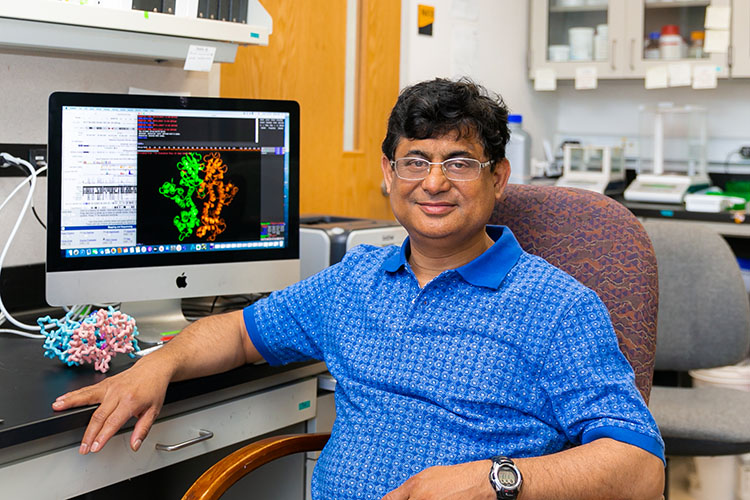
Madhusudan Dey, associate professor of biological sciences at UWM, shows the atomic structure of the protein he found. The protein plays a role in the process the cell uses to maintain proteostasis – a healthy balance of cellular proteins. (UWM Photo/Elora Hennessey)
The roughly 25,000 proteins in the human body can only do their jobs by folding into unique atomic shapes that correlate to various biological tasks. Many human disorders, including diabetes, Alzheimer’s disease and Parkinson’s disease, begin when proteins misfold or unfold due to cellular stress.
In a part of the cell where one-third of protein folding occurs, the endoplasmic reticulum, misfolded proteins can accumulate, tipping the healthy balance and setting off an alarm network – the unfolded protein response, or UPR, that also resolves the imbalance.
A researcher at the University of Wisconsin-Milwaukee has mapped the role of a newly discovered protein in the UPR. The work demonstrates new details about how the UPR operates and shows that it is more complicated than previously thought.
Using a yeast model, Madhusudan Dey’s research is charting the complicated signaling network with an eye toward finding targets for new drugs to treat diseases caused by protein misfolding in people.
UPR is both the sensor and the correction system for defective folding in the endoplasmic reticulum, said Dey, UWM associate professor of biological sciences. “It is the mechanism that spots anomalies and then sets off an intracellular system of signals to other proteins to correct the problem,” he said.
Dey has discovered that a new protein, kinase Kin1, plays a regulatory role in maintaining proteostasis – the healthy balance of cellular proteins. The UPR is one of two processes used to maintain proteostasis in the endoplasmic reticulum. But, until now, neither sufficiently explained how the newly discovered protein contributes.
In the mammalian cell, three protein molecules act as sensors and messengers in the UPR process, but only one of those protein molecules, called Ire1, is shared by both yeast and humans.
He and his lab members collected various yeast strains, made single genetic changes to them and then compared the communication pathways of the “mutants” to the unaltered yeast strains.
In this work, published in May in Science Signaling, Dey and his collaborators detangled the role of the kinase Kin1 protein in the lre1 pathway and found it enabled the activation of UPR. The team included members from Quinnipiac University, Yale University School of Medicine and Argonne National Laboratory.
Along with Ire1, two other proteins transmit ER stress signals in humans. Dey said this work suggests that there are likely more pathways to uncover that they work in concert with each other.
Some of these signaling pathways are also involved in cancer outcomes, he added. His lab is also trying to identify small molecules involved in disease where the signaling can be interrupted by turning a gene “on” or “off.”
UWM coauthors include Chandrima Ghosh, Jagadeesh Uppala, Leena Sathe and Ashish Anshu. The work was funded by a $1.3 million grant from the National Institute of General Medical Sciences, part of the U.S. Department of Health and Human Services.
By Laura Otto
